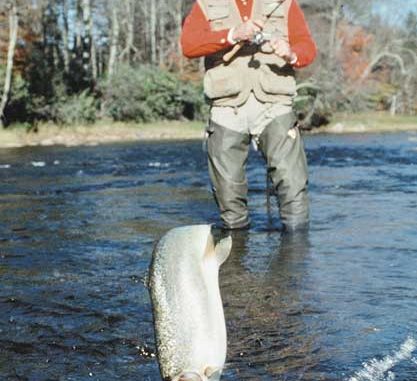
Development of the Gatawba River tailrace below Lake James adds a new N.C. trout fishery.
Angler Dave Canaan, talking about recent fishing trips, asked about a particularly good spot.“Been fishing?” he said.
“Went yesterday,” I said. “Trout fishing on the Catawba.”
Canaan was surprised.
“Trout on the Catawba River?” he said. “Where?”
Canaan, director of Mecklenburg County Water and Land Resources, works with the Catawba River near Charlotte. Like most Tar Heels, he thinks of the river as the series of impoundments with dams that create huge reservoirs for bass, crappie and catfish.
Yet in the tailrace below Lake James, a trout fishery of growing importance is thriving.
Michael “Squeak” Smith often fishes the Lake James tailrace, which is a few minutes from his home in Morganton. A a member of the Trout Unlimited’s board of directors, the N.C. Wildlife Federation’s Sportsman of the Year in 1997, and owner of a host of other awards and honors for his work furthering environmental integrity, among Smith’s goals is “creating a world-class trout fishery from Lake James to Morganton.”
Significant progress has been made.
Smith said the N.C. Carolina Wildlife Resources Commission began stocking trout below Lake James in the 1940s.
“It was a put-and-take sort of thing,” he said. “Trout were stocked in anticipation they would be caught and kept. But some of them didn’t get caught, and they drifted downstream and established a small, self-reproducing population.”
After long discussion, this section of the Catawba River has been designated “trout water.”
In the mid-1990s WRC biologists believed the Lake James tailrace could be a significant smallmouth bass fishery. Roughly 25,000 smallmouth were stocked but the program wasn’t successful.
“The smallmouth never really took hold,” Smith said. “Every now and then someone catches one. They’re still around. But the trout are much more successful.”
In addition to the resident population, nearly a decade ago the WRC stocked 25,000 brown trout below Lake James. A couple of years ago the WRC released 50,000 trout into the Catawba River in the Lake James tailrace.
Electro-shocking, a method for assessing the fish population by sending a mild electrical current through the water, reveals a significant level of natural reproduction of the trout stocked.
“Electro-shocking turns up quite a few fish that haven’t been tagged,” Smith said. “The only way they could get there is by natural reproduction. And some rainbows show up as well, and the rainbows have not been stocked recently.”
Where are the trout?
Below Lake James the Catawba River is free flowing; dams don’t impede its water.
The river goes where it wishes until it slows to enter Lake Rhodhiss. Between Lake James and Morganton, the best trout water, long stretches of relatively flat water mark the river’s course. In the western United States anglers call such stretches “runs.” That’s not to say the Catawba is “natural” because the river’s water is controlled by the Bridgewater Dam at Lake James.
Between the runs exist 26 shoals, and they’re marked by gravel and rock bottoms. Water tumbles across the gravel and swirls around the rocks. Although trout swim in the runs, Catawba trout anglers concentrate their effort on the shoals.
“I like the section from Muddy Creek to the Watermill takeout the best,” Smith said. “There are numerous shoals to work. From Watermill to Morganton is only fair due to decreased habitat.”
Bo Cash, who grew up fishing the Catawba River and is a member of the Table Rock Trout Unlimited chapter, agreed with Smith.
“The trout ‘lies’ are best around shoals where the insect populations are more plentiful and water is better oxygenated,” Cash said. “Long, dead stretches between theses shoals are mostly mud bottoms and not productive for trout. And there are more miles of this kind of water.”
Currently speaking
The Catawba below Lake James is a tailrace.
For wading anglers, that means the current is subject to change. Safety is always a critical concern in tailrace fishing.
If water is released from the upstream dam, the surge can carry away an angler or boat. While a siren at the dam may warn a release is coming, it may not be loud enough to reach anglers.
“The upper section — from the Bridgewater Dam to Muddy Creek — with generation is fast water,” said Rick Pons, also a member of Trout Unlimited and a Catawba River trout aficionado. “I’d suggest not wading or, if you are drifting, not to anchor.”
Cash agreed.
“Fishermen need to be on constant alert for the turbines to come on as Duke (Energy) does not follow predicted schedules very well,” Cash said. “The river below the dam has steep, jungle-like banks with briars and poison ivy, and it’s narrow. What this means to the wade fisherman is he or she is in extreme danger if caught by rapidly rising water. One can’t jump out of the river anywhere. The horns, which are supposed to sound at the powerhouse when turbines start, can’t be heard below the public parking area (at the base of the dam).”
As things stand now, the typical flow below Lake James is leakage from the dam that moves at about 25 cubic feet per second. At that rate, anglers can wade most of the river. While some spots would “float your hat,” a careful angler can cross the stream in safety.
If one turbine is operating at Bridgewater Dam, the flow is roughly 900 cfs; if two are generating power the flow is about 1800 cfs. Either rate of current means no wading for anglers.
For those who drift the river, 900 cfs is ideal, Pons said.
“The mid-section of the river is better fishing with around 900 cfs,” he said. “You can get out of a boat and wade fish most of the shoals.”
Water depths allow floats over shoals, but not so much that lures and flies can’t reach fish.
A couple of hours after the turbines have been turned off, fishing behind the surge of released water is optimum. Anglers may call the number for Duke Energy listed in the “Destination Information” portion of this article to determine the dam’s release schedule.
Rain impacts trout fishery below Lake James. Aptly named Muddy Creek enters the Catawba a mile or so below the Bridgewater Dam.
If it has rained in McDowell County where Muddy Creek starts, the Catawba River will get dirty within a day or two,” Pons said. “After the rains, you can count on the river being dirty for two to four days. That’s better than it was a few years ago before all of the restoration work along the upper banks of Muddy Creek.”
A number of years ago, the Table Rock Chapter of Trout Unlimited and Duke Power cooperated with local land owners to stabilize major stretches of Muddy Creek.
Gear
Trout anglers at the upper Catawba River use gear comparable to what trout anglers use across North America.
Cash is a fly-rod purist.
“Since I’m strictly a fly fisherman and mostly have been for some 51 years, I’m out of touch with hardware fishing,” he said.
He recommended dry flies such as Blue-Wing olives, sulphurs, Griffith’s Gnat or caddises. Cash’s favorite nymph patterns include pheasant tail, various caddis patterns and large and very dark stonefly nymphs, heavily weighted. He also fishes streamers.
“Streamers include heavily weighted muddlers and wooly buggers that I strip rapidly on sink tip lines from a moving drift boat,” he said.
That’s hard work but can be fruitful.
“There are really two principle hatches on this section of the Catawba — black caddis about the time of the ACC Basketball Tournament (early March) and big stone flies all year,” Smith said. “That’s why I tie up so many Nos. 4 or 6 weighted stone flies and work them around the head of the shoals.”
When many anglers tie streamers or large nymphs they want weighted, they wrap the hook shank with lead. But Smith doesn’t like either of these flies to be weighted.
“I want the fly to be low in the water column, but I want it to be a little off the bottom,” he said. “I put a sinker on the leader rather than weighting the fly.”
Smith’s favorite flies vary depending upon the time of year.
“It depends on the time of year,” he said. “March is No. black or green caddis time. May and June are No. 8 sulphur time. And No. 4 to No. 8 black stones produce year round.”
Fly rod anglers do best with 4-weight or 5-weight rods. The Catawba River at the tailrace is typically less than 150-feet wide, so Smith, Pons and Cash use rods between 7 ½-feet and 9-feet long, matched to the suggested lines.
“I run a 9-foot, 4-weight dry fly rod with 12-foot leaders and a 2- to 3-foot 5X or 6X tippet and a 9-foot, 5- or 6-weight rod with 8-foot leaders with a 3-foot, 4X or 5X tippet,” Smith said.
Smith recommended anglers carry a variety of weights to get flies deeper into the water column.
Spinning gear also is popular with Catawba River trout anglers. Ultra-light rods and 6-pound test line are appropriate.
“I like Yo-Zuri plugs, 3½-inch to 5-inch trout or shiner patterns as well as TD minnows,” Pons said. “They draw some of the larger browns out of the wood.”
Small Rapalas or other minnow-style jerkbaits also will work well for trout. Small Rebel crayfish or in-line spinners such as Mepps or Panther Martins are also good lures for trout, and work well when cast quartering upstream or quartering downstream and worked diagonally.
Prospects
Is this section of the Catawba River similar to fishing fishing at Montana? No.
“Is the river representative of pristine trout water?” Cash said. “Absolutely far from that.”
Several challenges exist, including perhaps the most important — access.
“Right now, access is pretty restricted,” Smith said.
Boat anglers with drift boats, canoes or kayaks can launch below Bridgewater Dam and float 8 miles to Watermill, a site built by and funded by the Table Rock’s TU chapter.
However, access should improve during the next few years. Duke Energy currently is seeking a new license from the Federal Energy Regulatory Commission to operate hydro-electric plants along the length of the Catawba River. Many persons participated in the citizen involvement portion of developing the proposed new license, including Smith and Cash.
Several hundred acres just downstream of the Bridgewater Dam have been designated for public use. Among the facilities anticipated as a result of the new license will be foot access below “Rollin-on-the-River” bridge, a mile or so below Bridgewater, as well as a boat launch site near the bridge.
Also among elements of the proposed new Duke license will be enhanced flows below Bridgewater. Anglers urged the new license require a minimum flow of 300 cfs, barring drought when all flows might be restricted. Duke agreed to increase flows and anglers accepted a minimum of 125 cfs.
Enhanced flows should increase insect populations, extend trout habitat and also improve access.
During 2007-08 a dispute developed whether the Lake James tailrace should be a legally designated trout water.
Jimmy Jacobs, author of “Tailwater Trout in the South,” said he expects the Catawba River tailwater to earn a spot in the next edition of his book.
“It’s been no secret for years throughout the Southern states the best places to tangle with some truly-magnum sized trout are in tailwater fisheries,” he said. “That situation is particularly true for brown trout on flows like the Catawba. As more tailwaters around the region are managed under special regulations — such as the delayed harvest section on the Tuckasegee River at Dillsboro and the Chattahoochee River in Georgia, or the slot limits imposed on the Cumberland River in Kentucky and South Holston in Tennessee — there is no reason to expect tailwater fisheries will get anything but better in the future.”
So, Dave Canaan, get out your fishing gear. Things are looking up for trout anglers in the central part of the Tar Heel state.

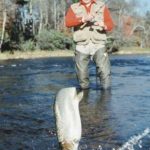

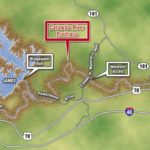
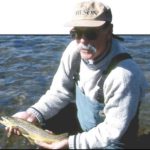
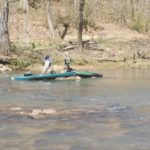
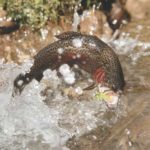


Be the first to comment